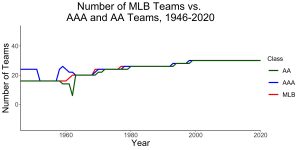Professor Qi Ge and Alex Eisert ’22, Economics Department
This summer, I was privileged to work on a project examining competitive balance and vertical integration in sports with Professor Ge. Specifically, we looked into the relationship between major (MLB) and minor (MiLB) league baseball. Hailing from New York, I am a lifelong Yankees (MLB) fan, and growing up, I also frequented Hudson Valley Renegades’ (MiLB) games during my summers in Dutchess County.

I donned a Renegades’ hat while holding up a picture of logos of the minor league teams with my favorite names.
A feeder or minor league is a lower-level, but still professional-grade entity that athletes usually participate in before moving to the highest level (or major league). The more that a sport’s minor leagues are tied to its major league, the more that major league can be said to have engaged in vertical integration; the minor leagues operate as a part of the supply chain for the majors. No such system is as expansive and complex, and perhaps as tightly integrated, like that of Organized Baseball.
My first task was to explore the relationship between MLB and MiLB throughout the years with a comprehensive literature review. 1921 marked the first year that MLB teams could have ownership stakes in minor league teams, and they immediately began buying up minor league teams as a place to put young ballplayers, signed for cheap, stashing them until they were ready for the major leagues.
My main task was to gather data on which MiLB teams have been MLB-owned, and on the performance of minor league teams throughout the years. We will ultimately use these datasets to look into the effects that MLB ownership has on league-wide competitive balance for the two highest levels of the minor leagues, AA and AAA.


